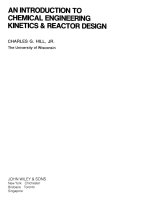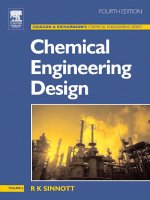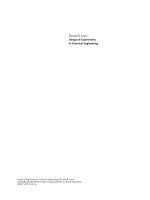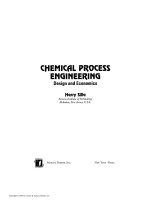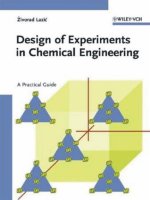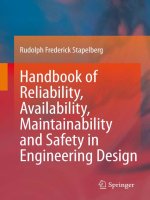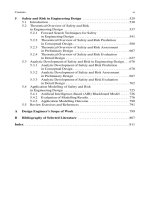chemical engineering design principles, practice and economics of plant and process design
Bạn đang xem bản rút gọn của tài liệu. Xem và tải ngay bản đầy đủ của tài liệu tại đây (23.26 MB, 1,266 trang )
CHEMICAL ENGINEERING
DESIGN
This page intentionally left blank
CHEMICAL ENGINEERING
DESIGN
Principles, Practice and
Economics of Plant and
Process Design
GAVIN TOWLER
RAY SINNOTT
AMSTERDAM • BOSTON • HEIDELBERG • LONDON
NEW YORK • OXFORD • PARIS • SAN DIEGO
SAN FRANCISCO • SINGAPORE • SYDNEY • TOKYO
Butterworth-Heinemann is an imprint of Elsevier
Butterworth-Heinemann is an imprint of Elsevier
30 Corporate Drive, Suite 400, Burlington, MA 01803, USA
525 B Street, Suite 1900, San Diego, California 92101-4495, USA
84 Theobald’s Road, London WCIX 8RR, UK
This book is printed on acid-free paper.
Copyright © 2008, Elsevier Inc. All rights reserved.
No part of this publication may be reproduced or transmitted in any form or by any means, electronic or
mechanical, including photocopy, recording, or any information storage and retrieval system, without
permission in writing from the publisher.
Permissions may be sought directly from Elsevier’s Science & Technology Rights Department in Oxford,
UK: phone: (+44) 1865 843830, fax: (+44) 1865 853333, E-mail: You may
also complete your request on-line via the Elsevier homepage (), by selecting ‘‘Support &
Contact’’ then ‘‘Copyright and Permission’’ and then ‘‘Obtaining Permissions.’’
No responsibility is assumed by the publisher or the authors for any injury and/or damage to persons or
property as a matter of products liability, negligence or otherwise, of from any use or operation of any
methods, products, instructions, data or ideas contained in the material herein.
Library of Congress Cataloging-in-Publication Data
Application Submitted
British Library Cataloguing-in-Publication Data
A catalogue record for this book is available from the British Library.
ISBN 13: 978-0-7506-8423-1
For information on all Butterworth-Heinemann publications
visit our Web site at www.books.elsevier.com
Printed in the United States of America
07 08 09 10
9 8 7 6 5 4 3 2 1
Cover Design: Joe Tenerelli
Gavin Towler is the Senior Manager of Process Design, Modeling and Equipment at UOP LLC.
He manages the areas of process design and optimization, equipment design, and physical and kinetic
modeling for UOP Research and Development. As adjunct professor at Northwestern University,
he teaches the chemical engineering senior design classes. He is a Chartered Engineer and Fellow of
the Institute of Chemical Engineers.
Ray Sinnott began his career in design and development with several major companies, including
DuPont and John Brown. He later joined the Chemical Engineering Department at the University of
Wales, Swansea, UK, publishing the first edition of Chemical Engineering Design in 1983. He is a
Chartered Engineer, Eur. Ing. and Fellow of the Institute of Chemical Engineers.
This page intentionally left blank
CONTENTS
PREFACE xv
HOW TO USE THIS BOOK
ACKNOWLEDGMENTS
1
INTRODUCTION TO DESIGN
1.1.
1.2.
1.3.
1.4.
1.5.
1.6.
1.7.
1.8.
1.9.
1.10.
1.11.
1.12.
2
xvii
xix
1
Introduction 2
Nature of Design 2
The Anatomy of a Chemical Manufacturing Process 8
The Organization of a Chemical Engineering Project 11
Project Documentation 13
Codes and Standards 16
Design Factors (Design Margins) 17
Systems of Units 18
Optimization 19
References 44
Nomenclature 44
Problems 45
FUNDAMENTALS OF MATERIAL BALANCES
2.1.
2.2.
2.3.
2.4.
2.5.
2.6.
2.7.
2.8.
2.9.
2.10.
49
Introduction 50
The Equivalence of Mass and Energy 50
Conservation of Mass 51
Units Used to Express Compositions 51
Stoichiometry 52
Choice of System Boundary 53
Choice of Basis for Calculations 56
Number of Independent Components 57
Constraints on Flows and Compositions 58
General Algebraic Method 59
vii
viii
CONTENTS
2.11.
2.12.
2.13.
2.14.
2.15.
2.16.
2.17.
2.18.
2.19.
2.20.
2.21.
3
74
FUNDAMENTALS OF ENERGY BALANCES AND ENERGY
UTILIZATION 81
3.1.
3.2.
3.3.
3.4.
3.5.
3.6.
3.7.
3.8.
3.9.
3.10.
3.11.
3.12.
3.13.
3.14.
3.15.
3.16.
3.17.
3.18.
3.19.
3.20.
4
Tie Components 60
Excess Reagent 62
Conversion, Selectivity, and Yield 63
Recycle Processes 68
Purge 70
Bypass 71
Unsteady-State Calculations 72
General Procedure for Material-Balance Problems
References 75
Nomenclature 75
Problems 76
Introduction 82
Conservation of Energy 82
Forms of Energy (Per Unit Mass of Material) 83
The Energy Balance 84
Calculation of Specific Enthalpy 89
Mean Heat Capacities 90
The Effect of Pressure on Heat Capacity 92
Enthalpy of Mixtures 94
Enthalpy-Concentration Diagrams 95
Heats of Reaction 98
Standard Heats of Formation 101
Heats of Combustion 102
Compression and Expansion of Gases 104
Energy Balance Calculations 112
Unsteady State Energy Balances 113
Energy Recovery 114
Heat Exchanger Networks 124
References 145
Nomenclature 146
Problems 150
FLOWSHEETING 153
4.1.
4.2.
4.3.
4.4.
Introduction 154
Flowsheet Presentation 155
Process Simulation Programs 162
Specification of Components and Physical Property Models
165
ix
CONTENTS
4.5.
4.6.
4.7.
4.8.
4.9.
4.10.
4.11.
4.12.
5
PIPING AND INSTRUMENTATION
5.1.
5.2.
5.3.
5.4.
5.5.
5.6.
5.7.
5.8.
5.9.
5.10.
5.11.
5.12.
5.13.
6
Simulation of Unit Operations 169
User Models 204
Flowsheets with Recycle 207
Flowsheet Optimization 219
Dynamic Simulation 224
References 224
Nomenclature 225
Problems 226
235
Introduction 236
The P and I Diagram 236
Valve Selection 241
Pumps and Compressors 243
Mechanical Design of Piping Systems 262
Pipe Size Selection 265
Control and Instrumentation 275
Typical Control Systems 277
Alarms, Safety Trips, and Interlocks 285
Computers in Process Control 287
References 289
Nomenclature 291
Problems 293
COSTING AND PROJECT EVALUATION
6.1.
6.2.
6.3.
6.4.
6.5.
6.6.
6.7.
6.8.
6.9.
6.10.
6.11.
6.12.
Introduction 298
Costs, Revenues, and Profits 298
Estimating Capital Costs 306
Estimating Production Costs and Revenues
Taxes and Depreciation 352
Project Financing 358
Economic Evaluation of Projects 363
Sensitivity Analysis 380
Project Portfolio Selection 384
References 388
Nomenclature 390
Problems 392
297
334
x
CONTENTS
7
MATERIALS OF CONSTRUCTION
7.1.
7.2.
7.3.
7.4.
7.5.
7.6.
7.7.
7.8.
7.9.
7.10.
7.11.
7.12.
7.13.
7.14.
7.15.
7.16.
8
397
Introduction 398
Material Properties 398
Mechanical Properties 399
Corrosion Resistance 402
Selection for Corrosion Resistance 407
Material Costs 408
Contamination 409
Commonly Used Materials of Construction 410
Plastics as Materials of Construction for Chemical Plants
Ceramic Materials (Silicate Materials) 419
Carbon 421
Protective Coatings 421
Design for Corrosion Resistance 421
References 422
Nomenclature 424
Problems 424
DESIGN INFORMATION AND DATA
8.1.
8.2.
8.3.
8.4.
8.5.
8.6.
8.7.
8.8.
8.9.
8.10.
8.11.
8.12.
8.13.
8.14.
8.15.
8.16.
8.17.
8.18.
8.19.
427
Introduction 428
Sources of Information on Manufacturing Processes 428
General Sources of Physical Properties 430
Accuracy Required of Engineering Data 432
Prediction of Physical Properties 433
Density 434
Viscosity 436
Thermal Conductivity 440
Specific Heat Capacity 442
Enthalpy of Vaporization (Latent Heat) 449
Vapor Pressure 451
Diffusion Coefficients (Diffusivities) 452
Surface Tension 455
Critical Constants 457
Enthalpy of Reaction and Enthalpy of Formation 460
Phase Equilibrium Data 460
References 472
Nomenclature 477
Problems 479
417
xi
CONTENTS
9
SAFETY AND LOSS PREVENTION 481
9.1.
9.2.
9.3.
9.4.
9.5.
9.6.
9.7.
9.8.
9.9.
9.10.
9.11.
9.12.
10
502
EQUIPMENT SELECTION, SPECIFICATION, AND DESIGN
10.1.
10.2.
10.3.
10.4.
10.5.
10.6.
10.7.
10.8.
10.9.
10.10.
10.11.
10.12.
10.13.
10.14.
10.15.
10.16.
11
Introduction 482
Materials Hazards 486
Process Hazards 493
Analysis of Product and Process Safety
Failure-Mode Effect Analysis 503
Safety Indices 506
Hazard and Operability Studies 517
Quantitative Hazard Analysis 526
Safety Checklists 531
References 534
Nomenclature 538
Problems 538
Introduction 542
Separation Processes 543
Solid-Solid Separations 543
Liquid-Solid (Solid-Liquid) Separators 550
Separation of Dissolved Solids 577
Liquid-Liquid Separation 582
Separation of Dissolved Liquids 590
Gas-Solid Separations (Gas Cleaning) 591
Gas-Liquid Separators 603
Crushing and Grinding (Comminution) Equipment
Mixing Equipment 609
Transport and Storage of Materials 620
Reactors 626
References 630
Nomenclature 635
Problems 637
609
SEPARATION COLUMNS (DISTILLATION, ABSORPTION,
AND EXTRACTION) 641
11.1.
11.2.
11.3.
11.4.
11.5.
11.6.
Introduction 642
Continuous Distillation: Process Description 642
Continuous Distillation: Basic Principles 645
Design Variables in Distillation 650
Design Methods for Binary Systems 652
Multicomponent Distillation: General Considerations
665
541
xii
CONTENTS
11.7.
11.8.
11.9.
11.10.
11.11.
11.12.
11.13.
11.14.
11.15.
11.16.
11.17.
11.18.
11.19.
12
HEAT TRANSFER EQUIPMENT
12.1.
12.2.
12.3.
12.4.
12.5.
12.6.
12.7.
12.8.
12.9.
12.10.
12.11.
12.12.
12.13.
12.14.
12.15.
12.16.
12.17.
12.18.
12.19.
12.20.
12.21.
13
Multicomponent Distillation: Shortcut Methods for Stage and
Reflux Requirements 667
Multicomponent Systems: Rigorous Solution Procedures
(Computer Methods) 693
Other Distillation Systems 697
Plate Efficiency 698
Approximate Column Sizing 708
Plate Contactors 709
Plate Hydraulic Design 716
Packed Columns 741
Column Auxiliaries 771
Solvent Extraction (Liquid-Liquid Extraction) 772
References 779
Nomenclature 784
Problems 789
793
Introduction 794
Basic Design Procedure and Theory 795
Overall Heat Transfer Coefficient 796
Fouling Factors (Dirt Factors) 798
Shell and Tube Exchangers: Construction Details 801
Mean Temperature Difference (Temperature Driving Force) 815
Shell and Tube Exchangers: General Design Considerations 820
Tube-Side Heat Transfer Coefficient and Pressure Drop (Single Phase)
Shell-Side Heat Transfer and Pressure Drop (Single Phase) 829
Condensers 870
Reboilers and Vaporizers 890
Plate Heat Exchangers 918
Direct-Contact Heat Exchangers 929
Finned Tubes 930
Double-Pipe Heat Exchangers 931
Air-Cooled Exchangers 932
Fired Heaters (Furnaces and Boilers) 932
Heat Transfer to Vessels 938
References 945
Nomenclature 951
Problems 957
MECHANICAL DESIGN OF PROCESS EQUIPMENT
13.1. Introduction 962
13.2. Pressure Vessel Codes and Standards
963
961
823
xiii
CONTENTS
13.3.
13.4.
13.5.
13.6.
13.7.
13.8.
13.9.
13.10.
13.11.
13.12.
13.13.
13.14.
13.15.
13.16.
13.17.
13.18.
13.19.
13.18.
14
Fundamental Principles and Equations 966
General Design Considerations: Pressure Vessels 980
The Design of Thin-Walled Vessels Under Internal Pressure
Compensation for Openings and Branches 993
Design of Vessels Subject to External Pressure 995
Design of Vessels Subject to Combined Loading 999
Vessel Supports 1013
Bolted Flanged Joints 1020
Heat Exchanger Tube Plates 1028
Welded-Joint Design 1031
Fatigue Assessment of Vessels 1033
Pressure Tests 1034
High-Pressure Vessels 1035
Liquid Storage Tanks 1038
Pressure-Relief Devices 1038
References 1053
Nomenclature 1056
Problems 1060
GENERAL SITE CONSIDERATIONS
14.1.
14.2.
14.3.
14.4.
14.5.
14.6.
14.7.
1065
Introduction 1066
Plant Location and Site Selection 1066
Site Layout 1068
Plant Layout 1069
Utilities 1074
Environmental Considerations 1076
References 1086
APPENDIX
A
B
C
D
E
F
G
H
I
986
1089
Graphical Symbols for Piping Systems and Plant 1089
Corrosion Chart 1099
Physical Property Data Bank 1119
Conversion Factors for Some Common SI Units 1141
Design Projects I 1145
Design Projects II 1165
Equipment Specification (Data) Sheets 1193
Typical Shell and Tube Heat Exchanger Tube-Sheet Layouts
Material Safety Data Sheet 1213
1207
This page intentionally left blank
Preface
This book was first published as Volume 6 of the Chemical Engineering series edited
by Coulson and Richardson. It was originally intended to be a standalone design
textbook for undergraduate design projects that would supplement the other volumes
in the Coulson and Richardson series. Emphasis was placed on the practice of process
and equipment design, while the reader was referred to the other volumes in the series
and other chemical engineering textbooks for details of the fundamental principles
underlying the design methods.
In adapting this book for the North American market, we have followed the same
philosophy, seeking to create a comprehensive guide to process plant design that
could be used as part of the typical chemical engineering curriculum, while providing
references to more detailed and specialized texts wherever necessary. The design
procedures can be used without the need for reference to the other books, research
papers, or websites cited.
We recognize that chemical engineers work in a very diverse set of industries,
and many of these industries have their own design conventions and specialized
equipment. We have attempted to include examples and problems from a broad
range of process industries, but where space or our lack of expertise in the subject
has limited coverage of a particular topic, references to design methods available in
the general literature are provided.
In writing this book, we have drawn on our experience of the industrial practice of
process design, as well as our experience teaching design at the University of Wales
Swansea, University of Manchester, and Northwestern University. Since the book is
intended to be used in practice and not just as a textbook, our aim has been to describe
the tools and methods that are most widely used in industrial process design. We have
deliberately avoided describing idealized conceptual methods developed by researchers
that have not yet gained wide currency in industry. The reader can find good descriptions of these methods in the research literature and in more academic textbooks.
Standards and codes of practice are an essential part of engineering; therefore,
the relevant North American standards are cited. The codes and practices covered
by these standards will be applicable to other countries. They will be covered by
equivalent national standards in most developed countries, and in some cases the
relevant British, European, or International standards have also been cited. Brief
xv
xvi
PREFACE
summaries of important U.S. and Canadian safety and environmental legislation have
been given in the relevant chapters. The design engineer should always refer to the
original source references of laws, standards, and codes of practice, as they are
updated frequently.
All of the costs and examples have been put on a U.S. basis, and examples have
been provided in both metric and conventional units. Where possible, the terminology used in the U.S. engineering and construction industry has been used.
Most industrial process design is carried out using commercial design software.
Extensive reference has been made to commercial process and equipment design
software throughout the book. Many of the commercial software vendors provide
licenses of their software for educational purposes at nominal fees. We strongly
recommend that students be introduced to commercial software at as early a stage
in their education as possible. The use of academic design and costing software should
be discouraged. Academic programs usually lack the quality control and support
required by industry, and the student is unlikely to use such software after graduation.
All computer-aided design tools must be used with some discretion and engineering
judgment on the part of the designer. This judgment mainly comes from experience,
but we have tried to provide helpful tips on how to best use computer tools.
The art and practice of design cannot be learned from books. The intuition
and judgment necessary to apply theory to practice will come only from practical
experience. We trust that this book will give its readers a modest start on that road.
Ray Sinnott
Gavin Towler
How to Use This Book
This book has been written primarily for students in undergraduate courses in chemical engineering and has particular relevance to their senior design projects. It should
also be of interest to new graduates working in industry who find they need to
broaden their knowledge of unit operations and design. Some of the earlier chapters
of the book can also be used in introductory chemical engineering classes and by other
disciplines in the chemical and process industries.
As a Senior Design Course Textbook
Chapters 1 to 9 and 14 cover the basic material for a course on process design
and include an explanation of the design method, including considerations of safety,
costing, and materials selection. Chapters 2, 3, and 8 contain a lot of background
material that should have been covered in earlier courses and can be quickly skimmed
as a reminder. If time is short, Chapters 4, 6, and 9 deserve the most emphasis.
Chapters 10 to 13 cover equipment selection and design, including mechanical
aspects of equipment design. These important subjects are often neglected in
the chemical engineering curriculum. The equipment chapters can be used as
the basis for a second course in design or as supplementary material in a process
design class.
As an Introductory Chemical Engineering Textbook
The material in Chapters 1, 2, 3, and 6 does not require any prior knowledge
of chemical engineering and can be used as an introductory course in chemical
engineering. Much of the material in Chapters 7, 9, 10, and 14 could also be used
in an introductory class. There is much to be said for introducing design at an early
point in the chemical engineering curriculum, as it helps the students have a better
appreciation of the purpose of their other required classes, and sets the context for the
rest of the syllabus. Students starting chemical engineering typically find the practical
applications of the subject far more fascinating than the dry mathematics they are
usually fed. An appreciation of economics, optimization, and equipment design can
dramatically improve a student’s performance in other chemical engineering classes.
xvii
xviii
HOW TO USE THIS BOOK
If the book is used in an introductory class, then it can be referred to throughout
the curriculum as a guide to design methods.
Supplementary Material
Many of the calculations described in the book can be performed using spreadsheets.
Templates of spreadsheet calculations and equipment specification sheets are available
in Microsoft Excel format online and can be downloaded by all readers of this book
from />
Resources for Instructors
Supplementary material is available for registered instructors who adopt Chemical
Enginering Design as a course text. Please visit for
information and to register for access to the following resources.
Lecture Slides
Microsoft PowerPoint presentations to support most of the chapters are available free
of charge to instructors who adopt this book. To preview PDF samples of the slides
please register with the site above. A complete set of slides on CD, in customizable
PowerPoint format, will be sent to qualifying adopters on request.
Image Bank
A downloadable image bank of artwork from the book to use in lecture presentations
is available.
Instructor’s Manual
A full solutions manual with worked answers to the exercises in the main text is
available for download.
Acknowledgments
As in my prefaces to the earlier editions of this book, I would like to acknowledge my
debt to those colleagues and teachers who have assisted me in a varied career as a
professional engineer. I would particularly like to thank Professor J. F. Richardson for
his help and encouragement with earlier editions of this book. Also, my wife, Muriel,
for her help with the typescripts of the earlier editions.
Eur. Ing. R. K. Sinnott
Coed-y-bryn, Wales
I would like to thank the many colleagues at UOP and elsewhere who have worked
with me, shared their experience, and taught me all that I know about design.
Particular thanks are due to Dr. Rajeev Gautam for allowing me to pursue this project
and to Dick Conser, Peg Stine, and Dr. Andy Zarchy for the time they spent reviewing
my additions to Ray’s book and approving the use of examples and figures drawn
from UOP process technology. My contribution to this book would not have been
possible without the love and support of my wife, Caroline, and our children
Miranda, Jimmy, and Johnathan.
Gavin P. Towler
Inverness, Illinois
Material from the ASME Boiler and Pressure Vessel Code is reproduced
with permission of ASME International, Three Park Avenue, New York, NY 10016.
Material from the API Recommended Practices is reproduced with permission of
the American Petroleum Institute, 1220 L Street, NW, Washington, DC 20005.
Material from British Standards is reproduced by permission of the British Standards
Institution, 389 Chiswick High Road, London, W4 4AL, United Kingdom. Complete
copies of the codes and standards can be obtained from these organizations.
We are grateful to Aspen Technology Inc. and Honeywell Inc. for permission to
include the screen shots that were generated using their software to illustrate the
process simulation and costing examples. Laurie Wang of Honeywell also provided
valuable review comments. The material safety data sheet in Appendix I is reproduced
with permission of Fischer Scientific Inc. Aspen Plus1, Aspen Kbase, Aspen ICARUS,
xix
xx
ACKNOWLEDGMENTS
and all other AspenTech product names or logos are trademarks or registered trademarks of Aspen Technology Inc. or its subsidiaries in the United States and/or in other
countries. All rights reserved.
The supplementary material contains images of processes and equipment from
many sources. We would like to thank the following companies for permission to use
these images: Alfa-Laval, ANSYS, Aspen Technology, Bete Nozzle, Bos-Hatten Inc.,
Chemineer, Dresser, Dresser-Rand, Enardo Inc., Honeywell, Komax Inc., Riggins
Company, Tyco Flow Control Inc., United Value Inc., UOP LLC, and The Valve
Manufacturer’s Association.
Jonathan Simpson of Elsevier was instrumental in launching and directing this
project. He and Lyndsey Dixon provided guidance and editorial support throughout
the development of this edition. We would also like to thank Heather Scherer,
Viswanathan Sreejith and Jay Donahue for their excellent work in assembling the
book and managing the production process.
The cover illustration shows the 100th CCR Platforminge unit licensed by UOP
and is reproduced with permission of UOP LLC.
1
INTRODUCTION
TO DESIGN
Chapter Contents
1.1. Introduction
1.2. Nature of Design
1.3. The Anatomy of a Chemical Manufacturing Process
1.4. The Organization of a Chemical Engineering Project
1.5. Project Documentation
1.6. Codes and Standards
1.7. Design Factors (Design Margins)
1.8. Systems of Units
1.9. Optimization
1.10. References
1.11. Nomenclature
1.12. Problems
Key Learning Objectives
&
How design projects are carried out and documented in industry
&
Why engineers in industry use codes and standards and build margins into their designs
&
How to improve a design using optimization methods
&
Why experienced design engineers very rarely use rigorous optimization methods in
industrial practice
1
2
1.1.
CHAPTER 1
INTRODUCTION TO DESIGN
INTRODUCTION
This chapter is an introduction to the nature and methodology of the design process
and its application to the design of chemical manufacturing processes.
1.2.
NATURE OF DESIGN
This section is a general discussion of the design process. The subject of this book is
chemical engineering design, but the methodology described in this section applies
equally to other branches of engineering.
Chemical engineering has consistently been one of the highest paid engineering
professions. There is a demand for chemical engineers in many sectors of industry,
including the traditional processing industries: chemicals, polymers, fuels, foods, pharmaceuticals, and paper, as well as other sectors such as electronic materials and devices,
consumer products, mining and metals extraction, biomedical implants, and power
generation.
The reason that companies in such a diverse range of industries value chemical
engineers so highly is the following:
Starting from a vaguely defined problem statement such as a customer need or a set of
experimental results, chemical engineers can develop an understanding of the important
underlying physical science relevant to the problem and use this understanding to create a
plan of action and set of detailed specifications which, if implemented, will lead to a
predicted financial outcome.
The creation of plans and specifications and the prediction of the financial outcome
if the plans were implemented is the activity of chemical engineering design.
Design is a creative activity, and as such can be one of the most rewarding and
satisfying activities undertaken by an engineer. The design does not exist at the start of
the project. The designer begins with a specific objective or customer need in mind
and, by developing and evaluating possible designs, arrives at the best way of achieving that objective—be it a better chair, a new bridge, or for the chemical engineer,
a new chemical product or production process.
When considering possible ways of achieving the objective, the designer will be
constrained by many factors, which will narrow down the number of possible designs.
There will rarely be just one possible solution to the problem, just one design. Several
alternative ways of meeting the objective will normally be possible, even several best
designs, depending on the nature of the constraints.
These constraints on the possible solutions to a problem in design arise in many
ways. Some constraints will be fixed and invariable, such as those that arise from
physical laws, government regulations, and standards. Others will be less rigid and
can be relaxed by the designer as part of the general strategy for seeking the best design.
The constraints that are outside the designer’s influence can be termed the external
constraints. These set the outer boundary of possible designs, as shown in Figure 1.1.
Within this boundary there will be a number of plausible designs bounded by the other
1.2.
3
NATURE OF DESIGN
Region of all designs
Resourc
es
s
on
Per
son
an
d
nel
ds
Metho
e
Tim
Possible designs
s
de
co
Eco
Plausible
designs
S
tan
da
rds
Materials
aints
nstr
i c co
nom
Pro
con cess
diti
ons
s
l law
s ic a
gu iceof
y Cho cess
et
pro
af
S
re
Phy
i
t
la
ols
Government contr
“External” constraints
“Internal” constraints
Figure 1.1.
Design constraints.
constraints, the internal constraints, over which the designer has some control, such as
choice of process, choice of process conditions, materials, and equipment.
Economic considerations are obviously a major constraint on any engineering design:
plants must make a profit. Process costing and economics are discussed in Chapter 6.
Time will also be a constraint. The time available for completion of a design will
usually limit the number of alternative designs that can be considered.
The stages in the development of a design, from the initial identification of the
objective to the final design, are shown diagrammatically in Figure 1.2. Each stage is
discussed in the following sections.
Figure 1.2 shows design as an iterative procedure; as the design develops, the
designer will be aware of more possibilities and more constraints, and will be constantly
seeking new data and ideas, and evaluating possible design solutions.
1.2.1.
The Design Objective (The Need)
All design starts with a perceived need. In the design of a chemical process, the need is the
public need for the product, creating a commercial opportunity, as foreseen by the sales
and marketing organization. Within this overall objective, the designer will recognize
subobjectives, the requirements of the various units that make up the overall process.
Before starting work, the designer should obtain as complete, and as unambiguous,
a statement of the requirements as possible. If the requirement (need) arises from
outside the design group, from a customer or from another department, then the
designer will have to elucidate the real requirements through discussion. It is important to distinguish between the needs that are ‘‘must haves’’ and those that are ‘‘should
4
CHAPTER 1
Determine
Customer Needs
INTRODUCTION TO DESIGN
Set Design
Specifications
Build Performance
Models
Generate Design
Concepts
R&D if Needed
Predict Fitness
for Service
Customer
Approval
Evaluate Economics,
Optimize & Select
Design
Detailed Design &
Equipment Selection
Figure 1.2.
Procurement
& Construction
Begin Operation
The design process.
haves.’’ The ‘‘should haves’’ are those parts of the initial specification that may be
thought desirable, but that can be relaxed if required as the design develops. For
example, a particular product specification may be considered desirable by the sales
department, but may be difficult and costly to obtain, and some relaxation of the
specification may be possible, producing a saleable but cheaper product. Whenever
possible, the designer should always question the design requirements (the project and
equipment specifications) and keep them under review as the design progresses. It is
important for the design engineer to work closely with the sales or marketing department or with the customer directly, to have as clear as possible an understanding of
the customer’s needs.
When writing specifications for others, such as for the mechanical design or purchase of a piece of equipment, the design engineer should be aware of the restrictions
(constraints) that are being placed on other designers. A well-thought-out, comprehensive specification of the requirements for a piece of equipment defines the external
constraints within which the other designers must work.
1.2.2. Setting the Design Basis
The most important step in starting a process design is translating the customer need into
a design basis. The design basis is a more precise statement of the problem that is to be
solved. It will normally include the production rate and purity specifications of the main
product, together with information on constraints that will influence the design, such as
1. The system of units to be used.
2. The national, local or company design codes that must be followed.
3. Details of raw materials that are available.
